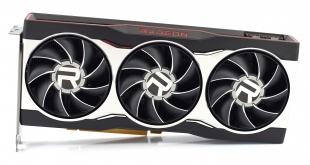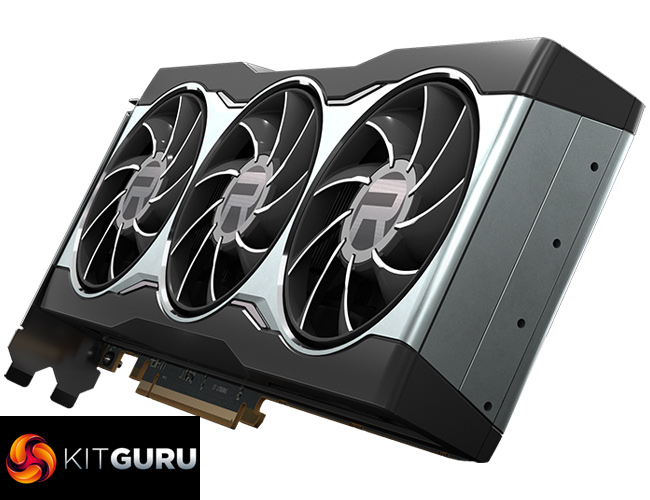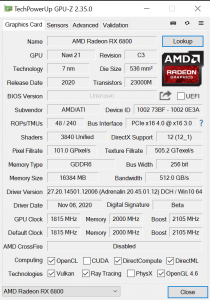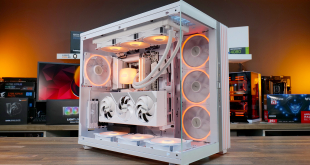
Today marks the launch of not just one, but two new GPUs from AMD. Both the RX 6800 and RX 6800 XT were officially announced on October 28, and here we put the RX 6800 under the microscope. With UK pricing set at £529.99, this GPU sits above the RTX 3070 and AMD is not shy about claiming that it is faster than the RTX 2080 Ti. We put this RDNA 2-based GPU through its paces and find out just how fast it really is.
While its RX 6800 XT is firmly positioned to take the RTX 3080 head-on, things are a little different for the AMD RX 6800. In the UK it is priced about £60 above the RTX 3070, so it's not massively more expensive but we would certainly expect better performance as a result. Considering the RTX 3070 is currently the cost per frame king, AMD also has its work cut-out to offer enticing value up against the Ampere GPU.
In this review, we test the RX 6800 over 14 games, with an eye on thermals, acoustics and power, to find out just how good it really is.
| RX 6800 XT | RX 6800 | RX 5700 XT | RX 5700 | |
| Architecture | RDNA 2 | RDNA 2 | RDNA | RDNA |
| Manufacturing Process | 7nm | 7nm | 7nm | 7nm |
| Transistor Count | 26.8 billion | 26.8 billion | 10.3 billion | 10.3 billion |
| Die Size | 519 mm² | 519 mm² | 251 mm² | 251mm² |
| Ray Accelerators | 72 | 60 | n/a | n/a |
| Compute Units | 72 | 60 | 40 | 36 |
| Stream Processors | 4608 | 3840 | 2560 | 2304 |
| Game GPU Clock | Up to 2015MHz | Up to 1815MHz | Up to 1755MHz | Up to 1625MHz |
| Boost GPU Clock | Up to 2250MHz | Up to 2105MHz | Up to 1905MHz | Up to 1725MHz |
| Peak SP Performance | Up to 20.74 TFLOPS | Up to 16.17 TFLOPS | Up to 9.75 TFLOPS | Up to 7.95 TFLOPS |
| Peak Half Precision Performance | Up to 41.47 TFLOPS | Up to 32.33 TFLOPS | Up to 19.5 TFLOPS | Up to 15.9 TFLOPS |
| Peak Texture Fill-Rate | Up to 648.0 GT/s | Up to 505.2 GT/s | Up to 304.8 GT/s | Up to 248.4 GT/s |
| ROPs | 128 | 96 | 64 | 64 |
| Peak Pixel Fill-Rate | Up to 288.0 GP/s | Up to 202.1 GP/s | Up to 121.9 GP/s | Up to 110.4 GP/s |
| AMD Infinity Cache | 128MB | 128MB | n/a | n/a |
| Memory | 16GB GDDR6 | 16GB GDDR6 | 8GB GDDR6 | 8GB GDDR6 |
| Memory Bandwidth | 512 GB/s | 512 GB/s | 448 GB/s | 448 GB/s |
| Memory Interface | 256-bit | 256-bit | 256-bit | 256-bit |
| Board Power | 300W | 250W | 225W | 185W |
While we talk more about the RDNA 2 architecture itself on the next page, here we can take a high-level overview of the Navi 21 GPU that forms the basis of the RX 6800.
Still fabricated on TSMC's 7nm process node, as per the RX 5000-series, Navi 21 sports a much larger GPU die, measuring 519 mm². For the RX 6800, it houses 60 Compute Units (CUs), with 64 Stream Processors each, giving a grand total of 3840 shaders.
Rated clock speed has increased significantly for the RX 6000 series. The RX 6800 though, isn't clocked quite as fast as the RX 6800 XT, with a rated game clock of 1815MHz and a boost clock of up to 2105MHz. To put that into perspective, the RX 5700 XT has a rated game clock of 1755MHz.
AMD has also increased the memory capacity, with 16GB of GDDR6 memory found on every RX 6000 SKU (so far). The memory is clocked at 16Gbps, and operates over a 256-bit memory interface for total bandwidth of 512 GB/s. However, as we will see on the next page, AMD has also implemented a 128MB Infinity Cache on the Navi 21 GPU, to significantly increase effective memory bandwidth without excess power draw.
Speaking of power, the RX 6800 has a rated total board power (TBP) of 250W, an increase of 25W versus the RX 5700 XT.
 KitGuru KitGuru.net – Tech News | Hardware News | Hardware Reviews | IOS | Mobile | Gaming | Graphics Cards
KitGuru KitGuru.net – Tech News | Hardware News | Hardware Reviews | IOS | Mobile | Gaming | Graphics Cards




